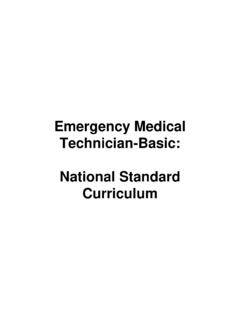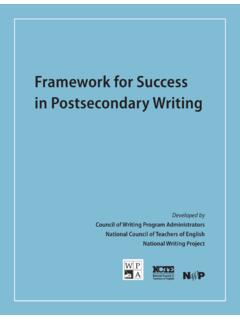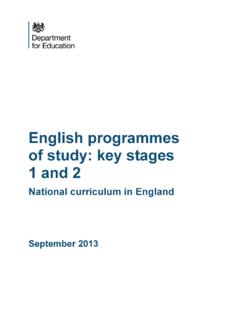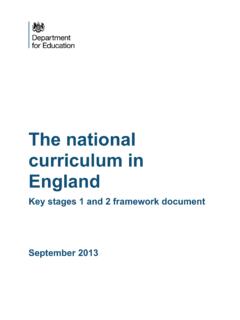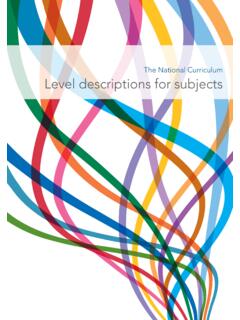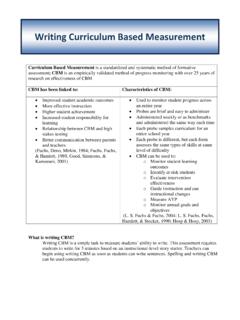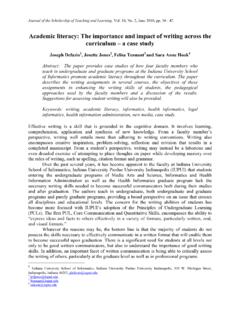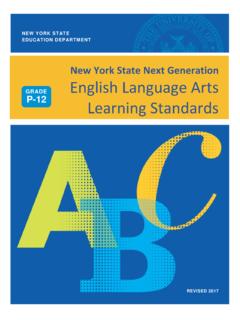Transcription of The national curriculum in England - GOV.UK
1 The national curriculum in England Framework document July 2013 2 Contents 1. Introduction 3 2. The school curriculum in England 4 3. The national curriculum in England 5 4. Inclusion 8 5. Numeracy and mathematics 9 6. Language and literacy 10 7. The programmes of study and attainment targets for the national curriculum subjects12 English 13 Mathematics 88 Science 136 Art and design 182 Citizenship 185 Computing 188 Design and technology 192 Geography 198 History 204 Languages 212 Music 217 Physical education 220 3 1. Introduction This document sets out the framework for the national curriculum and includes: contextual information about both the overall school curriculum and the statutory national curriculum , including the statutory basis of the latter aims for the statutory national curriculum statements on inclusion, and on the development of pupils competence in numeracy and mathematics, language and literacy across the school curriculum programmes of study for all the national curriculum subjects other than for key stage 4 English, mathematics and science.
2 A formal consultation on the key stage 4 programmes of study for these subjects will commence in the autumn term. Subject to the approval of Parliament, it is the government s intention that the final version of this framework will be published in the autumn of 2013, and that the elements that require statutory force will come into effect for the majority of year groups from September 2014. For pupils in year 2, year 6 and year 10, the new English, mathematics and science programmes of study will be introduced from September 2015; and for pupils in year 11 the programmes of study for these subjects will be introduced from September 2016. 4 2. The school curriculum in England Every state-funded school must offer a curriculum which is balanced and broadly based1 and which: promotes the spiritual, moral, cultural, mental and physical development of pupils at the school and of society, and prepares pupils at the school for the opportunities, responsibilities and experiences of later life.
3 The school curriculum comprises all learning and other experiences that each school plans for its pupils. The national curriculum forms one part of the school curriculum . All state schools are also required to make provision for a daily act of collective worship and must teach religious education to pupils at every key stage and sex and relationship education to pupils in secondary education. Maintained schools in England are legally required to follow the statutory national curriculum which sets out in programmes of study, on the basis of key stages, subject content for those subjects that should be taught to all pupils. All schools must publish their school curriculum by subject and academic year All schools should make provision for personal, social, health and economic education (PSHE), drawing on good practice.
4 Schools are also free to include other subjects or topics of their choice in planning and designing their own programme of education. 1 See Section 78 of the 2002 Education Act: which applies to all maintained schools. Academies are also required to offer a broad and balanced curriculum in accordance with Section 1 of the 2010 Academies Act; 2 From September 2012, all schools are required to publish information in relation to each academic year, relating to the content of the school s curriculum for each subject and details about how additional information relating to the curriculum may be obtained: 5 3. The national curriculum in England Aims The national curriculum provides pupils with an introduction to the essential knowledge that they need to be educated citizens.
5 It introduces pupils to the best that has been thought and said; and helps engender an appreciation of human creativity and achievement. The national curriculum is just one element in the education of every child. There is time and space in the school day and in each week, term and year to range beyond the national curriculum specifications. The national curriculum provides an outline of core knowledge around which teachers can develop exciting and stimulating lessons to promote the development of pupils knowledge, understanding and skills as part of the wider school curriculum . Structure Pupils of compulsory school age in community and foundation schools, including community special schools and foundation special schools, and in voluntary aided and voluntary controlled schools must follow the national curriculum .
6 It is organised on the basis of four key stages3 and twelve subjects, classified in legal terms as core and other foundation subjects. The Secretary of State for Education is required to publish programmes of study for each national curriculum subject, setting out the matters, skills and processes to be taught at each key stage. Schools are free to choose how they organise their school day, as long as the content of national curriculum programmes of study is taught to all pupils. 3 The key stage 2 programmes of study for English, mathematics and science are presented in this document as lower (years 3 and 4) and upper (years 5 and 6). This distinction is made as guidance for teachers and is not reflected in legislation. The legal requirement is to cover the content of the programmes of study for years 3 to 6 by the end of key stage 2.
7 6 The proposed structure of the new national curriculum , in terms of which subjects are compulsory at each key stage, is set out in the table below: Figure 1 Structure of the national curriculum Key stage 1 Key stage 2 Key stage 3 Key stage 4 Age 5 7 7 11 11 14 14 16 Year groups 1 2 3 6 7 9 10 11 Core subjects English Mathematics Science Foundation subjects Art and design Citizenship Computing Design and technology Languages4 Geography History Music Physical education All schools are also required to teach religious education at all key stages. Secondary schools must provide sex and relationship education. Figure 2 Statutory teaching of religious education and sex and relationship education Key stage 1 Key stage 2 Key stage 3 Key stage 4 Age 5 7 7 11 11 14 14 16 Year groups 1 2 3 6 7 9 10 11 Religious education Sex and relationship education 4 At key stage 2 the subject title is foreign language ; at key stage 3 it is modern foreign language.
8 7 Key stage 4 entitlement areas The arts (comprising art and design, music, dance, drama and media arts), design and technology, the humanities (comprising geography and history) and modern foreign language are not compulsory national curriculum subjects after the age of 14, but all pupils in maintained schools have a statutory entitlement to be able to study a subject in each of those four areas. The statutory requirements in relation to the entitlement areas are: schools must provide access to a minimum of one course in each of the four entitlement areas schools must provide the opportunity for pupils to take a course in all four areas, should they wish to do so a course that meets the entitlement requirements must give pupils the opportunity to obtain an approved qualification.
9 8 4. Inclusion Setting suitable challenges Teachers should set high expectations for every pupil. They should plan stretching work for pupils whose attainment is significantly above the expected standard. They have an even greater obligation to plan lessons for pupils who have low levels of prior attainment or come from disadvantaged backgrounds. Teachers should use appropriate assessment to set targets which are deliberately ambitious. Responding to pupils needs and overcoming potential barriers for individuals and groups of pupils Teachers should take account of their duties under equal opportunities legislation that covers disability, race, religion or belief, sex and sexual orientation. A wide range of pupils have special educational needs, many of whom also have disabilities.
10 Lessons should be planned to ensure that there are no barriers to every pupil achieving. In many cases, such planning will mean that these pupils will be able to study the full national curriculum . The SEN Code of Practice will include advice on approaches to identification of need which can support this. A minority of pupils will need access to specialist equipment and different approaches. The SEN Code of Practice will outline what needs to be done for them. With the right teaching, that recognises their individual needs, many disabled pupils have little need for additional resources beyond the aids which they use as part of their daily life. Teachers must plan lessons so that these pupils can study every national curriculum subject. Potential areas of difficulty should be identified and addressed at the outset of work.










